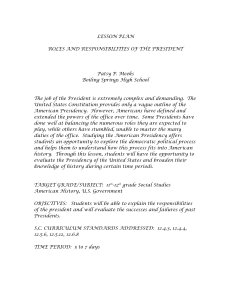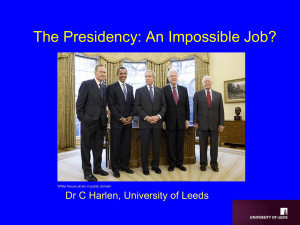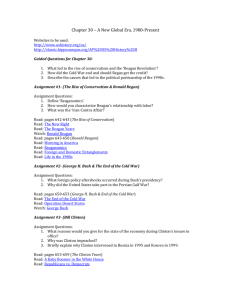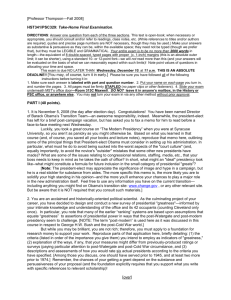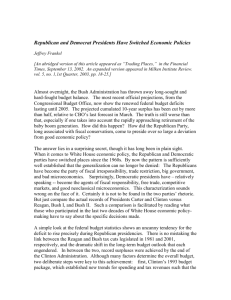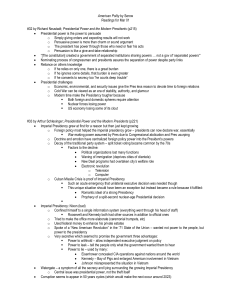The Presidency and the Constitution
advertisement
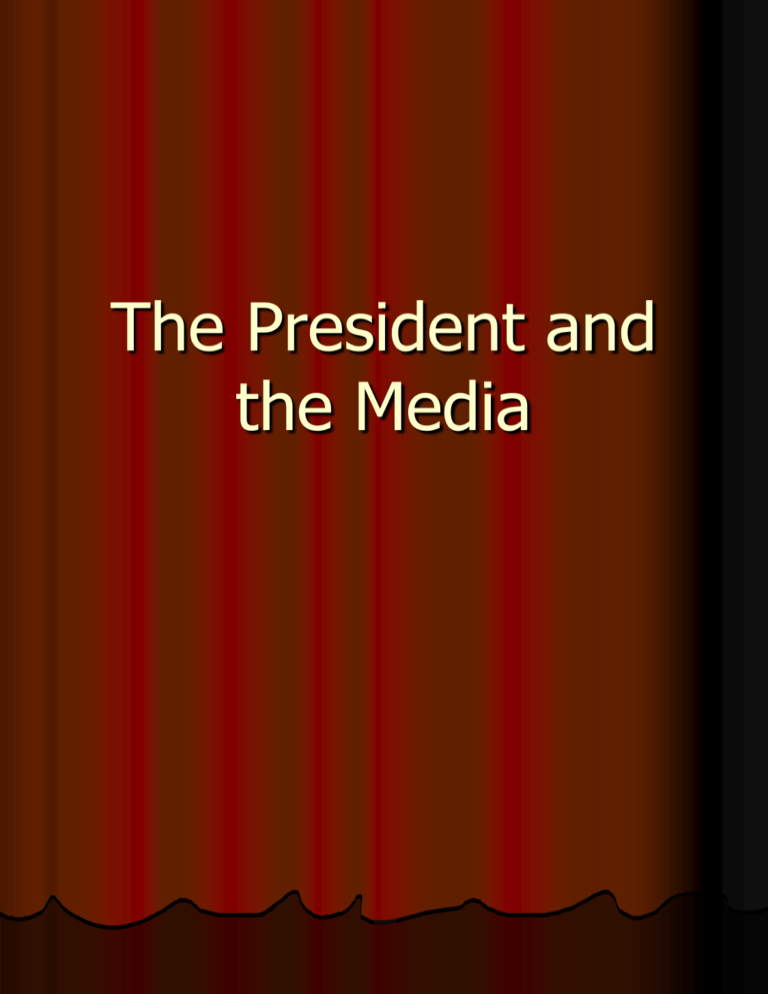
The President and the Media President Media Relationships The relation between the president and media can best be evaluated in terms of a game between the president and media. In order to understand this game we need to understand the interests of each actor in engaging in interactions. The president has both short and long term goals. He wants: 1) Favorable approval. 2) Policy favorability. 3) To establish his historical legacy. The media wants: 1) Information on the conduct of the presidency that satisfies a highly elastic demand function. That is, the media is usually unwilling to pay a high price (in terms of effort or time spent) for the news. As the price goes up, their demand goes sharply down. 2) Favorable ratings by their editors and more generally by the public. Demand for readers and editors tends them to focus on the negative, rather than the positive. The president tends to be highly informed (or at least his staff does) about the types of information it is willing to let the media have. The presidency is generally, but not fully in control, of what the media wants, information. The media has something the president wants, namely, control over an instrument which can facilitate approval, policy goals of the president, as well as the president’s historical legacy. The relation is, therefore, a strategic one in which both actors have something the other wants. Bargaining of a sort occurs to produce resultants. The president wants: A sense from the media of what is going on in the world. The pulse of the public and a feeler for important topics. The media to convey the president’s messages to other political leaders both at home and abroad. The media to help in communication with the mass public. Visibility above and beyond that of other political leaders. The media provide the public with most of what they know about the president and presidency. The media is the principal intermediary between the president and the public. Many recent presidents read newspapers and listened to the media in order to know what was being said from and about them. The New York Times, Washington Post, Wall Street Journal. Kennedy, Johnson, and Reagan were avid TV watchers. Johnson was almost paranoid about the news and reputedly had a three tv cabinet so he could watch all three network news at once. Johnson also had teletypes in the White House so he could catch wire service releases. Reagan liked westerns, caring less about news Relations with the press are an important part of the president’s effort to “lead” public approval. Because of the great importance of the press to the president, the White House goes to great lengths to encourage the media to project a positive image of the president and his policies. Coordinating the news, holding press conferences, formal briefings, interviews, photo-ops, background sessions, providing travel accommodations, and daily press handouts. The presidency is highly strategic in manipulating information for release to the media. However, the presidency cannot be fully in control of information, or in the media’s interpretation of information. Leaks. Yellow journalism. The media filters what is written and said about the president and administration based on journalistic values and demand. The media is not simply a parrot of presidential rhetoric, but an important and independent actor in its own right. First Amendment: Congress shall make no law respecting an establishment of religion, or prohibiting the free exercise thereof; or abridging the freedom of speech, or of the press; or the right of the people to peaceably assemble, and to petition the Government for redress of grievances. Yet, from the beginning, government has attempted to place restrictions on the press. Alien and Sedition Acts of 1798- The Adams administration jailed many Democratic-Republican partisan news editors and others for public opposition to the Quasi-War with France Espionage Act of 1917- The Wilson administration prosecuted and emprisoned Socialist Party leader Eugene Debs for making statements considered disloyal to the World War I effort. Snowden indicted under this law. Congress passes the Sedition Act of 1918, which forbids spoken or printed criticism of the U.S. government, the Constitution or the flag. 1941- Roosevelt pardons those convicted earlier under the Espionage and Sedition Acts. However, Congress also authorizes Roosevelt to create the Office of Censorship. A plethora of court cases dealing with free press. See http://www.firstamendmentcenter.org/firstamendment-timeline Evolution of Media Coverage In the Founding Era most media coverage occurred through the print media. Between 1790 and 1808, the number of newspapers in the United States grew from 92 to 329. All but 56 were identified with a political party. Printed pamphlets were also an important means of communications. Technical innovations between 1860 and 1920 permanently altered the press in the U.S.. Electronic printing press, telegraph, typewriter, telephone, linotype, woodpulp paper. Newspapers grew in importance, and electronic media increased the rate at which information could be transmitted. The public became increasingly literate. With these developments the presidency was no longer an isolated institution. Innovations in the media accelerated in the 1950s with television. In the 1980s with cable news networks. And in the 1990s with the internet. Now it is very easy to get news on the presidency and coverage is sometimes around the clock for important issues. The press has always subjected the president to criticism, from Washington onwards. Washington said, that the “calumnies” against his administration were “outrages of commmon decency” motivated by the desire to destroy confidence in the new government. Adams was so upset with the press that he supported the Alien and Sedition Acts. He actually jailed many journalists under its authority. Abigail Adams was very upset at the personal attacks on her husband, including references to “his rotundity” and bald head. One could argue that the press “brought down” the Johnson presidency with reporting on Vietnam, as well as the Nixon presidency through the relentless journalism of Woodward and Bernstein, and deep throat. The Reagan presidency was treated, relatively speaking, with kid gloves by the press until the Iran-Contra scandal broke. Some have argued that this was because Reagan was a former member of the press elite. However, his vulnerability showed through with Iran-Contra. George H. W. Bush was unhappy with the media’s portrayal of Bush as an elitist and a bumbler. The Clinton administration was unhappy with initial press treatment during his campaign and after (personal allegations of corruption with no basis; did not deal with the issues in the campaign). Initially, Clinton did not have “insiders” dealing with his press coverage, but rather brought on board campaign advocates. When hired David Gergen he did better. Relatively speaking, George W. Bush received a prolonged holiday from the press, especially after 9/11. Very little negative coverage during the 2000 election campaign and up until the Iraq invasion. However, during the 2004 election year and after, that changed considerably as the news media picked up on problems with the incumbency and war skepticism. The non-partisan Center for Media and Politics conducts and/or reports studies of how presidents and candidates fare with the mainstream media. http://cmpa.com For example, to see how various candidates in prior elections fared with the press you might look at this study of the 2004 election. http://cmpa.gmu.edu/wpcontent/uploads/2013/10/prev_pres_elect ions/2004/04novdec.pdf Or, to see how Obama has fared with the press since the 2008 election you might check out this link. http://cmpa.gmu.edu/obamas-mediaimage-compared-to-what/ Or, this one gives a comparative perspective. http://cmpa.gmu.edu/study-obamasmedia-coverage-sours/ The media is particularly interested in reporting a scandal. So much so that they sometimes rush with a story that might become a scandal, without first confirming the the facts. For example, consider the controversy over Hillary Clinton’s use of a personal email account. Check out this report from Media Matters http://mediamatters.org/blog/2015/03/12/cnn -quietly-updates-sloppy-report-on-clintonem/202870 I can tell you from personal experience that they almost always get it wrong with the stuff I’ve given them. White House To Media Relations Who regularly covers the White House? Newspapers such as the Washington Post, New York Times, Wall Street Journal, weekly news magazines like Time, Newsweek, U.S. News and World Report; wire services like Associated Press, United Press International, Reuters; newspaper chains like Hearst, Scripps-Howard, Newhouse, KnightRidder; television and news networks like ABC, CBS, NBC, CNN. More than 1700 persons have White House press credentials. However, fewer than 70 reporters and 15 photographers regularly cover the White House. Most newpapers have no regular Washington correspondent. A few political scientists are also allowed in the press room (e.g., Martha Joynt Kumar, Towson University). The presidential press operation. About 1/3 of the high-level White House staff is directly involved in media relations and policy of one type or another. Most staff members are involved at one time or another in cultivating the media’s portrayal of the president. White House Press Secretary is the person most often dealt with. These individuals are responsible for two way interactions. From the president to the media, and from the media to the president. Conduits of information from the White House to the press. Public policy statements; White House press releases; Responsible for making sure that policy and position is clear (or unclear) under some circumstances. The hold private meetings with reporters. The credibility of the Press Secretary rests on two important factors: 1) truth and 2) access to the president. For example, Clinton’s first press secretary, Dee Dee Myers was perceived as not being close to the inner circle. As a result she didn’t last very long. Who is President Obama’s current Press Secretary? Josh Earnest. He is Obama’s third Press Secretary and took over from Jay Carney who left to work for CNN. Press secretaries also serve as conduits from the press to the president. They transmit needs from the press. Press secretaries are not typically involved in substantive decisionmaking, but they are sometimes asked for advice on what information should be released, by whom, in what form, and to what audience. Office of Communications coordinates the flow of news from the entire executive branch. targets local non-Washington news outlets. develops a long-term news management plan for the president. Through their press secretaries, presidents communicate through daily press briefings. You can see these daily press briefings at http://www.whitehouse.gov/briefingroom/press-briefings . Presidents also communicate through Major Speeches and various media events, usually staged. You can read these off the White House web site at the links for major speeches. http://www.whitehouse.gov/ Recent presidents have used a weekly address, usually on Saturday. This originated during the F. D. Roosevelt administration, was used by presidents sporadically after that, but has been used by all presidents since Reagan regularly. Reagan through Bush II, radio; Bush II, podcasts; Obama video and podcasts. You can listen (sometimes) or read the text of the president’s weekly address by going to the link at http://www.whitehouse.gov/briefingroom/weekly-address Presidential press conferences- Direct interaction between the president and the media’s representatives. With the advent of television, these were also direct interactions between the president and the public. Truman through Reagan generally employed a large room. In 1982 Reagan began holding full scale mock news conferences. Presidents have frequently begun their news conferences with a carefully prepared opening statement. An attempt to control the agenda and also to use the media for their own purposes. Clinton had a practice of granting time to “local” media, in effect bypassing the national media. Presidents, through these opening statements, attempted to jump over the reporters going directly to the people. Recently the television networks have diminished coverage of news conferences because of their inability to control the agenda. They were seen as political tools of the president, rather than the advantage fo the media. Recent presidents have used fewer formal news conferences. Frequency has varied through time from about seven a month during Roosevelt to about one every two months during Nixon and Reagan. Bush I broke with tradition and held instead brief informal sessions with reporters, often called on short notice. Clinton had an antagonistic view of the press and did not hold his first for 2 months, and until 5 months before he held done in prime time viewing hours. Hired David Gergen. In your text you get a sense of how often different presidents have used news conferences. Bush II rarely held a news conference. Obama gives interviews and speeches, but seldom holds a news conference. Other services for the press. Background discussion with reporters for policy initiatives. Most common is called a “briefing”. Briefings provide information on anything current, from policy initiatives to family pets to the president’s health. Gives the press lines on the president’s mood and ideas. See the press briefings at http://www.whitehouse.gov/briefingroom/press-briefings Interviews with the president or top White House officials are a valued commodity. Sometimes the White House uses these for its own purposes. A strategic game. Presidents have regularly “cultivated” elite reporters and columnists, trying to turn them to their own purposes. Transcripts of briefings. Presidential speeches Daily handouts including myriad information about the president and policies Advance notice of travel plans Upcoming stories Major announcements Arranging transportation and lodging for the press on trips Technical support including installing equipment permanently, obtaining telephones for reporters, platforms for photographers. Reporters tend to view mid-level aides as the best source of information. Have in depth knowledge and free from constraints of high visibility. The press is “very” dependent on the support of the White House in several ways. 1) Information, 2) Technical support. The press NEEDS information and the best place to get it is the White House. The press operate in very much a controlled environment. White House manipulates “subject matter”, timing of releases, wording of releases, and tries to manipulate the media to its own advantages. Media Coverage of the Presidency As noted earlier, the media is an independent actor in the American system. This is guaranteed by the first amendment and norms of the profession. One important norm of the media profession is objectivity. Reporters who are biased in their coverage rarely achieve prominence. Another important norm is to verify sources for stories. A single source is not enough. It must be verified by multiple sources. Yet another norm is confidentiality of sources. Reporters tend to view mid-level aides as the best source of information on the presidency. Have in depth knowledge and are free from constraints of visibility. Leaks are an important phenomenon in media coverage of the presidency. The White House would like to control the flow of information, but usually can’t fully. Reporters vigorously protect the identity of “spokes-persons.” Witness for example the melee over who leaked the identity of an undercover CIA agent in retaliation for exposing intelligence on transfer of nuclear technology to Iraq. This was associated with President Bush’s State of the Union address who cited the intelligence. The easy solution for the investigation would have been to simply ask the six reporters. However, they would not give up the name claiming first amendment privilege without extreme coercion. Who leaks information? Everyone. David Stockman released information on Reagan’s willingness to compromise on the 81 tax bill. Oliver North leaked information on the Achille Lauro highjackers. Clinton’s image of dishonesty flowed out of the continual leaks from Ken Starr’s Office of Special Whitewater Prosecutor. These were leaks that were virtually all unsubstantiated. No one ever knew the source of the leaks because of the norm of confidentiality. Likewise, someone in the Bush White House/administration leaked the identity of an undercover CIA operative to at least six reporters, apparently in retaliation for exposing weak intelligence relating to the president’s State of the Union message. Scooter Libby, press secretary for Dick Cheney went to jail over this leak. It is a violation of U.S. law to “out” a security operative. Sometimes leaks are inadvertent. Other times they are deliberate to bolster or damage the administration on particular policy matters. Not all favor the president’s position. Other times they are deliberate to gain strategic policy advantage or to mis-inform. Leaks can have many purposes depending on who is doing the leaking, friends or enemies. Trial balloons Effort to get favorable reporting on particular policy Send signals to foreign nations Disavow publicly after a leak Personnel matters to get a resignation Force the president’s hand on foreign policy matters. Depending on the media type, there may be an air of superficiality to media coverage of the president. Newspapers tend to be more in-depth and less superficial than visual media. Organizational imperatives from the media are to get information, any information on the president. This is driven by organizatonal imperatives. Most media coverage on the presidency is therefore superficial, characterized by brevity and simplicity. In particular since the 30 minute news cast is the source of most people’s news, about a 3 minute spot is the most allowable. This severely limits information transmission. Another reason for the superficiality is that “there is little new under the sun.” The presidency is still the presidency, and once the uniqueness of a new presidency has worn off there is little new to report. Yet another reason for the superficiality is the limited training and lack of specialization of the White House press corps. They often don’t know much about politics, the constitution, or the issues in democracy. Therefore, they focus on “politics” in the infighting sense, as well as personalities, rather than issues and matters of substantive policy concern. With the print media, despite the glamour of investigative reporting such as with Woodward and Bernstein, the Washington Post, and Watergate, precious little is done. It takes too much time, and is too uncertain of a payoff to the reporter. Occasionally one sees a story with some potential payoff, but the risks are great for devoting substantial resources to a story such as the leak on the undercover CIA operative. Emphasis on short run in coverage of the presidency. Emphasis on trivia, rather than important substantive policy matters. Does the press show a systematic bias for or against particular presidents? Not generally according to most political science quantitative empirical research. Why no bias? Norm of objectivity. Reporters tend not to be from one political party, so that while one reporter may be biased, there may be others in the other direction. Rotating assignments produces more objective news coverage. Basically both Democrats and Republicans fall under the critical eye of the press. The press prefers to frame the news in themes. Once a theme is established, it is hard to shed. Ford depicted as a bumbler, Carter as a weak, indecisive leader, Dan Quayle as an “ignoramus”, which he was not, Reagan as a great symbolic leader, Bush I as a waffler on “no new taxes”, Clinton as caring about people, but also dishonest and a womanizer, and the current Bush as ???. Is the media effective in influencing approval of the president? Most studies have found little or no relation between media coverage of the president and public approval. Why not? The media affect perceptions, rather than attitudes. The public’s familiarity with political matters is closely related to the amount of time they are exposed to media coverage. The media is an agenda setter. People readily adopt the media’s perception of what issues are important. While the question of what issues are important is determined by the media, the question of how to feel about those issues is determined more by partisanship and political values. There is growing evidence that network news helps to provide a frame of reference for issues and that this affects evaluations of the president. Iran-Contra coverage coincided with a dip in Reagan’s approval. Experiments found that President Carter’s overall reputation and competency were affected by network news coverage. The press is good at producing images. For example, Carter’s image as indecisive flowed out of press coverage of the Iran Hostage crisis.
